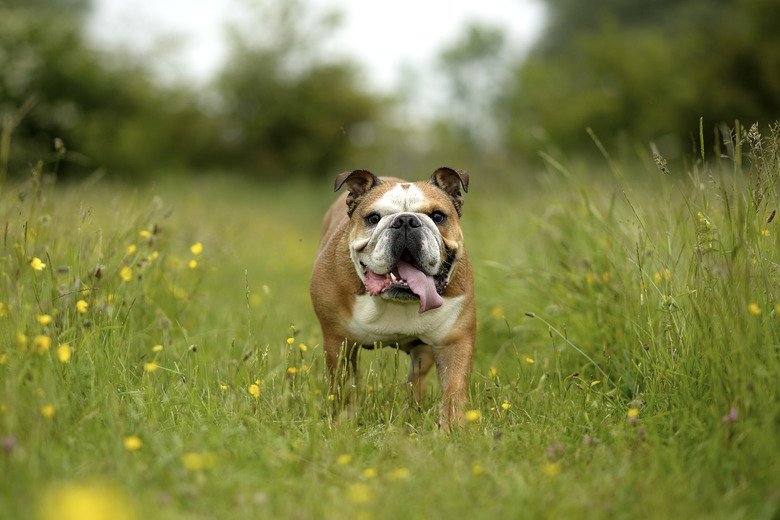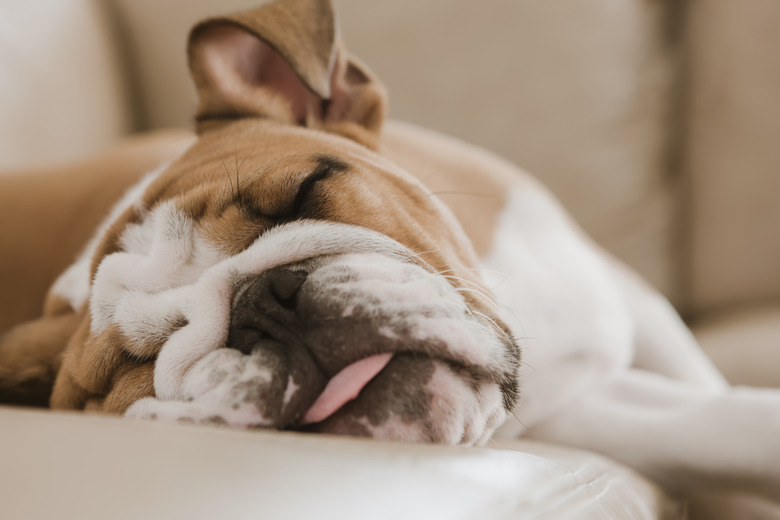English Bulldog Dog Breed Facts & Information
Few would call him poetry in motion, but an English bulldog's waddle, wrinkled face, and curlicue tail might bring on a case of puppy love at first sight. He has an ancient history in England of bull baiting. However, more than a century of selective breeding by reputable breeders has created a calm, dignified gentleman who would rather observe than fight. If you can out-stubborn the bulldog during training, his docile nature can make him your perfect companion dog.
The English bulldog is naturally associated with England, but not only because of the name. During the Second World War, the bulldog became a source of national pride in England thanks to a resemblance to Prime Minister Churchill. Since then, the easily identifiable large head and jowls of the British bulldog has become the mascot for many sports teams and the U.S Marine Corps. The English bulldog is an unmistakable dog breed.
English bulldog characteristics
English bulldog characteristics
English bulldogs, also called the British bulldog, are recognizable thanks to their large heads, pushed-in nose, small lower jaw accented by sagging chops, a furrowed brow, and small ears. The loose folds of skin around their large heads add character. They are one of the dog breeds popular in England, though they are sometimes confused with the French bulldog that also has a short coat
The average height of the bulldog, either male or female, is 14 to 15 inches at the shoulder. Males usually weigh about 50 pounds, and females slightly less at 40 pounds. English bulldogs range in color including fallow, red, brindle, and fawn, usually with white accents, and have short smooth coats. Brindle is the most popular English bulldog color. The lifespan of the bulldog is 8 to 10 years.
English bulldog temperament & training
English bulldog temperament & training
Breeders have worked hard to weed out the fearless aggression that once enabled an English bulldog — identified as simply "bulldog" by the American Kennel Club — to latch onto the nose of a 2000-pound bull during the inhumane ancient practice of bull-baiting. However, the tenacity that allowed the bulldog to hold that bull for as long his human wanted has been left mainly intact. It shows up these days as the bulldog's stubborn willfulness to claim your couch as his own or take whatever path interests him during daily walks.
Breed is not always a reliable indicator of personality: however, the bulldog's general friendly nature makes the bulldog a good companion dog for singles, couples, and families. The bulldog is known to have a special affinity for children and won't mind a lot of activity around the house. The bulldog typically gets along well with other pets and will thrive in the city, suburbs, or country as an indoor dog. Your English bulldog needs supervision around kids, though, since his mature weight of 40-to-50 well-muscled pounds could send a toddler flying accidentally.
A socialized and well-trained English bulldog will happily accompany you on family vacations or evening trips to a dog-friendly café. To mix socializing with training, try an obedience class led by a reputable trainer. As with any purebred dog purchased from breeders, training should involve positive reinforcement. Getting started early, as young as 10 weeks, with positive obedience training will teach an English bulldog to follow your lead rather than ignore your pleas to mind his manners.
English bulldog grooming needs
English bulldog grooming needs
This short-haired breed is prone to skin infections and conditions, such as dermatitis. Help prevent health issues by brushing your English bulldog three times a week with a soft rubber brush to remove dead hair and distribute his natural skin oils. The bulldog's facial wrinkles need daily cleansing with an unscented baby wipe to prevent yeast or bacteria from growing and creating health problems.
Use a damp cloth to remove tear stains quickly, since these can lead to secondary bacterial infection. Grooming sessions will become a special treat for your English bulldog if you start early in puppyhood and reward your brindle bulldog's good behavior with lots of praise. As with all dogs, English bulldogs require regular nail trims.
English bulldog exercise and health
English bulldog exercise and health
It might be hard to picture your nap-loving bulldog moving hard and fast toward an angry bull. Less athletically built than his ancestors, today's English bulldog requires moderate exercise, but will never be your jogging companion. In fact, you should not exercise an English bulldog intensely for long periods because they are brachycephalic and prone to heatstroke.
A bulldog's size can be a problem. His large head, stocky build, and flattened nose put the bulldog at risk for overheating and breathing problems, especially when it's hot. English bulldogs are brachycephalic dogs, and their respiratory systems are compromised as a result of selective breeding. However, brisk daily walks will help keep the bulldog's joints healthy and body lean. If you're ready for some extracurricular fun, healthy British bulldogs have enough energy for agility, rally, and obedience events.
English bulldog puppies
English bulldog puppies
English bulldogs are popular dogs, especially brindle pups, and purebred bulldog puppies tend to be expensive for two reasons: litters are usually small because of the size of the dog. The average English bulldog litter size is three or four puppies. Also, because of the bulldog's massive head, even at birth, delivery requires a veterinary a Caesarean section.
English bulldogs or British bulldogs are brachycephalic dog breeds, meaning airway issues and difficulty breathing are health problems with the bulldog. Therefore, finding a reputable breeder is important. The Bulldog Club of America can be a good source for breeders. Also, many bulldog breeders are listed with the American Kennel Club (AKC). The British Kennel Club in England likely has the longest list of English bulldog breeders. Though the British bulldog isn't the national dog of England, the bulldog is strongly associated with that country.


